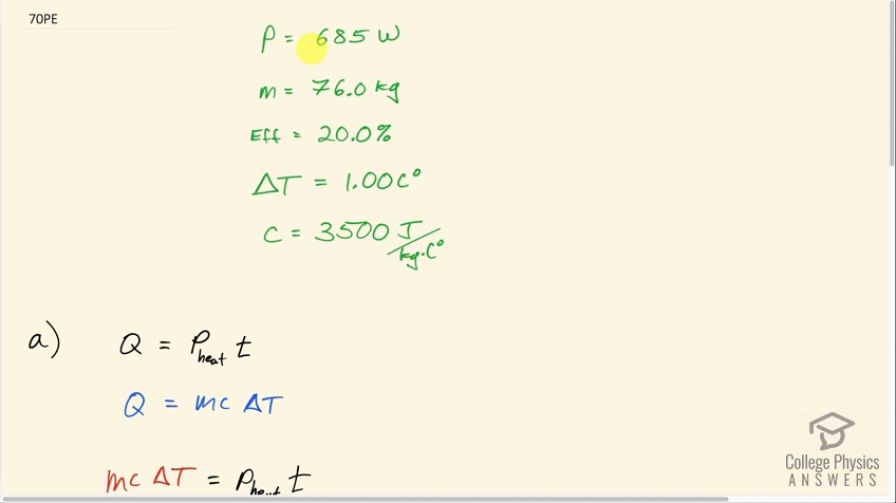Question
(a) Suppose you start a workout on a Stairmaster, producing power at the same rate as climbing 116 stairs per minute. Assuming your mass is 76.0 kg and your efficiency is 20.0% , how long will it take for your body temperature to rise
if all other forms of heat transfer in and out of your
body are balanced? (b) Is this consistent with your experience in getting warm while exercising?
Final Answer
- Yes, after ~1.5 min of vigorous exercise my body feels warmer, and the body starts sweating in order to cool.
Solution video
OpenStax College Physics for AP® Courses, Chapter 14, Problem 70 (Problems & Exercises)

vote with a rating of
votes with an average rating of
.
Calculator Screenshots
Video Transcript
This is College Physics Answers with Shaun Dychko. A 76.0 kilogram person is climbing stairs at a rate of 116 stairs per minute and to find the power output of that exercise, we have to look back to chapter 7, table [7.5], and find climbing stairs—116 steps per minute—is 685 watts. So this is the power output of the person. They have an efficiency of 20 percent and they are going to have a change in temperature in their body of 1.00 Celsius degree and the specific heat of the human body is 3500 joules per kilogram per Celsius degree. Okay! So the total heat energy absorbed by their body is going to be the rate at which heat is produced so we'll call that power subscript heat multiplied by time and this amount of energy will also be their mass times their specific heat times their change in temperature. So we can equate these two things and then we'll be able to solve for the amount of time by dividing both sides by the P heat. Now we need to figure out what this is though... it's not 685 because this is the useful power output. Now efficiency is the power output divided by the total rate at which energy is consumed which is the power input and we'll solve for P in by multiplying both sides by P in divided by efficiency and we get that the power input is the power output divided by efficiency and then the P heat—the rate at which heat energy is produced— is the difference between the rate at which energy is consumed minus how much is output as useful mechanical power. So this power input is P out divided by efficiency and we can factor out the P out. So we have P out times 1 over efficiency minus 1 is the rate at which the heat is produced. So when we solve this for time by dividing both sides by P heat, we get that the time is mcΔT over P heat and then we replace this P heat with P out times 1 over efficiency minus 1 and then we plug in numbers. So it's 76.0 kilograms times 3500 joules per kilogram per Celsius degree times 1.00 Celsius degree— temperature change— divided by 685 watts—power output— times 1 over 0.200—efficiency—minus 1 and that is 97.1 seconds. So in that amount of time, their body temperature will increase by 1.00 Celsius degree. And then this is consistent with experience and doing vigorous exercise, my body feels warmer after one and a half minutes— that's what this is— and the body starts to sweat in order to cool itself off after about one and a half minutes of vigorous exercise.
